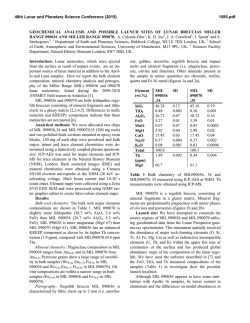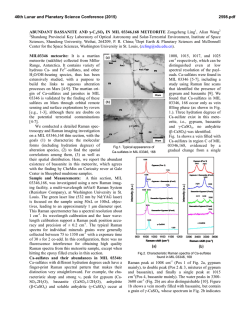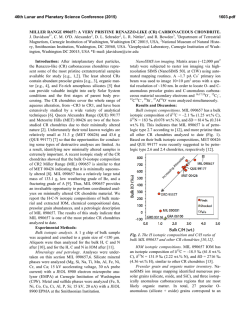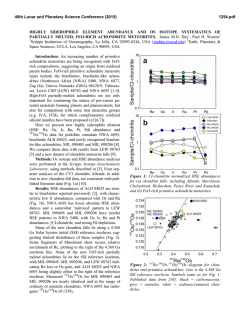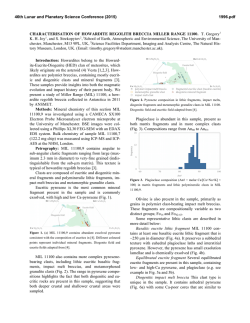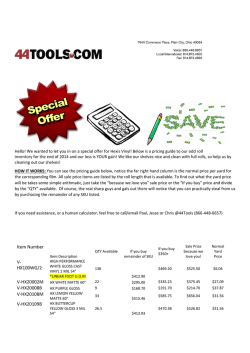
THLR rangecard user manual
THLR RANGECARD Instruction pdf (ver 1) 1 M/SEC 1:50K METER 2 3 4 5 7.5 10 15 20 MIRAGE cm 7 0 KM/H 4 2 2 5 2 MPH 5 10 C B +3 +4 +4 +5 GAP +5 TH SHOOTING HIGHER/ OVER VISIBLE WIND ADD + CLICKS TO WIND CORRECTION D F G TARGET RANGE/ SCOPE TURRET/ DESCRIPTION H 4 I 1 22 • 2 0.75 RETICLE HOLDOVER PLAN 10 12 14 16 18 5 8 + 6 A +2 +3 26 30 1 0.50 0 0 MOA/100M ½ ¾ MILLING SHOULDER ▼ 50˚ .64 + • ▼ 0.9 • 1 WIND LOG • 40˚ LEAD .76 LIGHT • • + 34 cm 0.25 PRESS/ DA/ ALT TEMP 30˚ .86 20˚ V0 .93 10˚ .98 0˚ ▼ +1 MIL 1 MIL 0.8 MIL 0.6 MIL 0.4 MIL = SHOOT! = 475 M = 595 M = 792 M = 1187 M THLR.NO THLR RANGECARD Main features 4 6 MPH 2 5 3 4 5 7.5 10 15 20 5 A 10 C B 4 +2 +3 +3 +4 3 +4 +5 GAP +5 TH SHOOTING HIGHER/ OVER VISIBLE WIND ADD + CLICKS TO WIND CORRECTION D F G TARGET RANGE/ SCOPE TURRET/ DESCRIPTION H 5 4 I 1 22 6 2 0.75 • RETICLE HOLDOVER PLAN 8 10 12 14 16 18 5 2 2 + 2 2 KM/H MIRAGE cm 7 0 1 1 M/SEC 1:50K METER 26 30 1 0.50 7 .64 ▼ 50˚ • 8 + ½ ¾ 11 0.9 • 1 WIND LOG • 40˚ .76 LIGHT • 9 • + 0 0 MOA/100M ▼ 34 cm 0.25 TEMP 30˚ 10 PRESS/ DA/ ALT .86 20˚ V0 .93 10˚ .98 MILLING SHOULDER LEAD +1 MIL 1 MIL 0.8 MIL 0.6 MIL 0.4 MIL 0˚ ▼ = SHOOT! = 475 M = 595 M = 792 M = 1187 M 12 THLR.NO 1. Ruler. Measure range on map, centimeters or MOA group size. 2. Mirage angle/ wind velocity illustration 3. Windage corrections for shooting high over visible wind 4. Columns for sketch legend 5. Reticle holdover plan 6. Sketch area with vanishing point 7. Tool for measuring shooting angle 8. Factors for crosswind component OR shooter error log 9. Additional weather log entry points 10. Colums for weather/ ammunition data 11. Aid for leads on moving targets 12. Aid for using the reticle MIL scale for range estimation. THLR RANGECARD Abstract «Fullfill the most important functions of traditional military sketches. Move decisions away from the timeframe of target ID – shot. Add a few safety pins against «brain-freeze». Make it packable, lightweight, weather resistant and semi-expendable. Add log functions to build habit of packing/ using the rangecard. Add training support by patterning shooter error.» THLR RANGECARD 1. 1:50K METER 1:50K METER 1:50K METER 0 2 4 4 8 10 12 14 16 18 4 2 2 4 2 1 1 cm 0.25 34 0 MOA/100M 0.50 30 cm 0.75 26 0.25 34 34 0 MOA/100M 0.50 30 30 0.25 0.75 26 26 0.50 1 22 22 22 0.75 Measure range on maps scaled 1:50000. Read top-down, example from to reads range approximately 1925 meters. It is presumed you know how to use a map. 2. Centimeter ruler. Read bottom – up, example from reads 5 centimeters. 3. Ruler for measuring your groups size in MOA (measuring the spread of your bullet holes). This ruler is scaled for 100 meters (European range use) and makes it easier to participate in the great internet debate. Read bottom – up, example from to reads 0,5 MOA group size. to 5 6 8 10 12 14 16 18 5 6 8 10 12 14 16 18 5 6 1 1 4 4 2 1 2 2 2 cm 0 0 2 1. cm 7 3 cm 7 2 cm 7 1 0 MOA/100M THLR RANGECARD 2. Mirage angle illustration MIRAGE M/SEC 1 2 MPH 2 3 5 4 5 10 • Use this when you can see mirage through your optics • Compare the angle you see in your optics with the angle on the Rangecard illustration. • Read off the assosciated wind velocity. • This wind is the crosswind component, it can be used directly for ballistic input. Example: You see that the mirage angle is slightly more than 45 degrees angle. The closest match is this circle 3 Use value 3 m/sec to read off your ballistic table Note: Reading mirage can be very difficult. Look for the straightest lines in your field of view, that is often the easiest spot to determine the mirage angle. Reading mirage is not nearly as exact as reading the wind. The values on the Snipertool is easy to use, but after 600 meters you will find that you are slightly overcompansating on the windage. When the mirage runs level, the crosswind component is at least 5 m/sec and you have a huge chance of error. We recommend reading wind over mirage when it approaches horisontal angle. THLR RANGECARD 3. Windage corrections for shooting high over visible wind • SHOOTING HIGHER/ OVER VISIBLE WIND ADD + CLICKS TO WIND CORRECTION +2 +3 +3 +4 +4 +5 GAP +5 • • • • • These numbers just acknowledge that wind velocity increase with elevation above ground. These numbers are not a ballistic calculation, just a simplified indicator to help build your own experience. Base your windcall on visual indicators and adjust your scope windage for that. In cases where you are shooting the bullet far over the visual indicators you used for the windcall, add some clicks on the scope. Where you can see the wind along the bullets trajectory DO NOT add these clicks. Use the first column (+2/+3) when you shoot the bullet approximately 10 meters above your visual indicator for the windcall. The last column when your «very far» above your visual indicator. «GAP» is used when you have a gap that will compress and blow a very strong wind across your bullet trajectory. It is a wild guess and basically says «good luck with that shot!» Note: The illustration shows a grossly simplified model where we extrapolated the wind velocity along a bullet trajectory shot across a valley. These numbers are calculated from elevation alone and does NOT represent the true spotwind, they merely illustrate a principle. If the shooter can see the wind only at his location (3 m/sec), it is fairly evident that he will undercompensate on his windage. In the illustrated example the bullet travels «very far» above the visual indicators and the shooter adds +4/+5 clicks to at least pull the bullet in the right direction. If the shooter sees visual indicators along the bullet trajectory, no such corrections is added regardsless of how far above ground the bullet travels. THLR RANGECARD 4. Columns for sketch legend • A B C House 410 410m / 17 UP 410m / 17 UP F G TARGET RANGE/ SCOPE TURRET/ DESCRIPTION 16 UP H • D I • • In rangecard mode, the letters A-I refers to a point on the target sketch (see feature 6). The letter «E» means bad luck and is not included. In example A the point on the sketch is named «house» and ranged to «410» in order to have a communication reference point. Example B simply states range «410m» and it requires «17 UP» on the scope elevation (or reticle holdover) to accurately shoot a target in point B. Example C is the rangecard used in log mode. We have a at «410m» and the ballistic program suggested «17up» on the scope elevation to shoot this target. Test shooting revealed that a center hit on the target only needed «16 up». Note: Example C is one of our favorite uses of this feature. When verifying your trajectory, pre-plan all your targets and write in the suggestions of the ballistic program. Log the actual elevation setting directly below. It makes for a very efficient shooting sessions and gives you structured, quality notes for your ballistic afterwork. We always verify our rifle trajectories this way, we never trust ballistic programs without verifications. We always click the scope to record accurate settings and not perceived scope-holdovers. THLR RANGECARD 5 Reticle holdover plan B A C D RETICLE HOLDOVER PLAN + • • • • • The letters A,B,C,D corresponds to points A,B,C,D found in the «Columns for sketch legend» (feature 4) and the same A,B,C,D found in the target sketch (feature 6). The points in the target sketch refers to targets or significant points. You sometimes need to shoot your target inside a very small timeframe – this will exclude the task of clicking your scope turret. Usually a scope setting other than your zero is more useful when wathing an area. Example: If your primary target area is range 400 to 450 meters away, then leaving the scope zeroed for 100 meters is just stupid. You set it to 425 in order to have the shortest possible response time to targets appearing here. If a fleeting target suddenly appears a longer range, a quick shot by holding over with the scope reticle can be difficult. Your holdover data is referenced to your normal zero. Your options are using holdovers with reduced accuracy or using time (and possibly not getting the shot off in time) to click the scope. If you pre-plan and plot these scenarios, you can have an effetive scope setting and at the same time have quick, accurate holdovers. A target in area C can be accurately shot with holdover . THLR RANGECARD 6 Sketch area The sketch area (feature 6) works closely together with the columns for sketch legend (feature 4) and reticle holdover plan (feature 5). We assume you have been taught to do sketches and coordinate your reference points. House 410 450 (LOW) B C D Road 540 Rock 480 450 (TOP) F G TARGET RANGE/ SCOPE TURRET/ DESCRIPTION HOLD H Trench 810 65 UP + A I C D D• A B C In this example the shooter have made a simple (but sufficient for orientation) target sketch, plotted four significant points (A, B, C, D) and pre-planned how to quickly shoot targets in these areas. For targets at A and B the shooter will simply aim and shoot as his scope is pre-set to 450. If a very small target is presented, he can correct by aiming (LOW) or (TOP) on the target. For targets at C he will simply hold the reticle over as indicated by position C in the Reticle holdover plan. For target D he will click the scope if time permits, if not he will use holdover D. THLR RANGECARD 7 Tool for measuring shooting angle 50˚ .64 40˚ .76 Aim across top 30˚ .86 20˚ .93 10˚ .98 0˚ ▼ • This scale is for measuring your angle when shooting uphill or downhill. • Aim at your target across the top of the card. • Gravity will pull the carry string down across the scale. • Read off degrees if you use a precalculated ballistic table. • Read off consine if you calculate via Riflemans Rule or similar. Example: We aim at the target across the top of the card. Picture shows downhill. Aim opposite direction if uphill. Gravity pulls the carry string down. Read off the scale. In this example just shy of 35°. (The illustration shows the THLR Snipertool. The function is identical on THLR Rangecard.) THLR RANGECARD Main features 4 6 MPH 2 5 3 4 5 7.5 10 15 20 5 A 10 C B 4 +2 +3 +3 +4 3 +4 +5 GAP +5 TH SHOOTING HIGHER/ OVER VISIBLE WIND ADD + CLICKS TO WIND CORRECTION D F G TARGET RANGE/ SCOPE TURRET/ DESCRIPTION H 5 4 I 1 22 6 2 0.75 • RETICLE HOLDOVER PLAN 8 10 12 14 16 18 5 2 2 + 2 2 KM/H MIRAGE cm 7 0 1 1 M/SEC 1:50K METER 26 30 1 0.50 7 .64 ▼ 50˚ • 8 + ½ ¾ 11 0.9 • 1 WIND LOG • 40˚ .76 LIGHT • 9 • + 0 0 MOA/100M ▼ 34 cm 0.25 TEMP 30˚ 10 PRESS/ DA/ ALT .86 20˚ V0 .93 10˚ .98 MILLING SHOULDER LEAD +1 MIL 1 MIL 0.8 MIL 0.6 MIL 0.4 MIL 0˚ ▼ = SHOOT! = 475 M = 595 M = 792 M = 1187 M 12 THLR.NO 1. Ruler. Measure range on map, centimeters or MOA group size. 2. Mirage angle/ wind velocity illustration 3. Windage corrections for shooting high over visible wind 4. Columns for sketch legend 5. Reticle holdover plan 6. Sketch area with vanishing point 7. Tool for measuring shooting angle 8. Factors for crosswind component OR shooter error log 9. Additional weather log entry points 10. Colums for weather/ ammunition data 11. Aid for leads on moving targets 12. Aid for using the reticle MIL scale for range estimation. THLR RANGECARD 8 Factors for crosswind component OR shooter error log 0 ½ ¾ ▼ + • • ▼ 0.9 • 1 WIND LOG • If used for finding the crosswind components, do this: • Determine wind velocity • Determine wind angle • Multiply wind velocity with wind angle • The result is crosswind component. Crosswind component is the effective wind that moves your bullet impact. Example: You determine wind to be 4 m/sec (you see the vegetation starts to lie down). Next determine the wind angle relative to your shooting direction (pyramid). 4 m/sec by approximately ¾ value is 3 m/sec. 3 m/sec is the value you use to read data from your rangecard. Note: We say «approximately» because wind direction have a normal variation that is invisible to the shooter. Therefore it is perfectly ok to round off values to easy numbers. We have put in more accurate decimal numbers for reference… good luck using those! THLR RANGECARD 8 Factors for crosswind component OR shooter error log 0 ½ ¾ ▼ + • • ▼ 0.9 • 1 WIND LOG • If used for finding the shooter error, do this: • Plot the shots that do not strike intended POI, regardless of range or target type. • With time a pattern will build and you will see systematic and occasional errors. • By focusing your training effort, it is easier to reach new performance levels. Example: This shooter has most of his misses striking down towards the left. Occasionally he sends a few shots down left and even up left. By analyzing the pattern, we can guess the shooter will have best effect by focusing on not pulling the trigger or the grip towards himself. His occasional mistakes indicates he every now and then shoves the rifle butt with the shoulder. A common mistake for fatigued or stressed shooters. Perhaps just an awareness and a mental check of the shoulder right before the shot will remove this error alltogether. Up left often indicates an unsettled foreend. Perhaps he just put too much pressure on the bipod for that one shot? Don’t worry overly much on rare mistakes, just be aware. THLR RANGECARD 9 Additional weather log entry points LIGHT WIND • • A LIGHT WIND • 4 • B We personally don’t use these entry points, put other shooters have different preferences. Example A shows direction of wind and light logged. Example B show direction and wind velocity logged THLR RANGECARD 10 Columns for weather/ ammunition data • + • TEMP 11 PRESS/ DA/ ALT 992 V0 792 • These three columns can be filled in in both rangecard or log mode. In rangecard mode, fill in air temperature and air pressure in whatever unit of measure you prefer. Crosscheck this with ammunition V0 data if you have it, and make a decision wether or not this will affect your trajectory. In log mode, handle your ammunition carefully so the ammunition V0 from the chronograph can be reliably linked to the ambient air temperature. Note: Shield your thermometer from direct sun exposure or radiation heat from body. Correct air temperature is measured in a shaded area. For our personal use, we prefer Kestrel weather handheld weatherstations as they have proven reliable over time. THLR RANGECARD 11 Aid for leads on moving targets + LEAD If you must consult this aid, it is fair to presume you will miss your target. All this feature does is force a mental process and so the shooter makes a few decisions ahead. It is unlikely to fit your ammunition/ range/ target combination. THLR RANGECARD 12 Aid for using the reticle MIL scale for range estimation • MILLING SHOULDER +1 MIL 1 MIL 0.8 MIL 0.6 MIL 0.4 MIL = SHOOT! = 475 M = 595 M = 792 M = 1187 M • • • It is presumed you know how to MIL a target with your scope reticle. With reliable lasers available, reticle milling for range estimation is rarely used. A laser is not always available, and math can be diffucult under stress. This coarse scale gives accurate enough range estimation for a short range shot or a good enough range estimation to place the shot inside your field of view, making a strike possible to observe. Note: The scale is calculated from a target 475 millimeters wide. Personell targets are rarely facing you squarely. THLR RANGECARD Our prefered marker for the THLR Rangecard is a hardness 2B lead pencil. This is slightly softer than the common HB and is easier to use in rain.
© Copyright 2025

